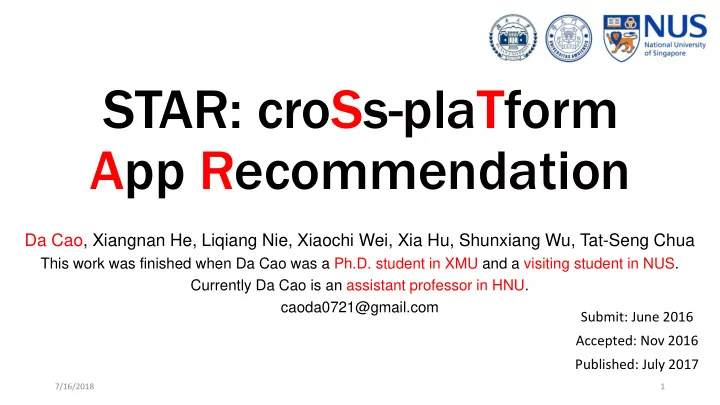

STAR: croSs-plaTform App Recommendation Da Cao, Xiangnan He, Liqiang Nie, Xiaochi Wei, Xia Hu, Shunxiang Wu, Tat-Seng Chua This work was finished when Da Cao was a Ph.D. student in XMU and a visiting student in NUS. Currently Da Cao is an assistant professor in HNU. caoda0721@gmail.com Submit: June 2016 Accepted: Nov 2016 Published: July 2017 7/16/2018 1
Outline • Background • Proposed Method • Experiments and Results • Conclusion 7/16/2018 2
App Development Mobile Network App-Driven Life Multi-Platform Overwhelmed 7/16/2018 3
Two App Recommendation solutions Who wins? Single Platform Cross-Platform VS Russia Croatia 7/16/2018 4
Challenges • Platform Variance • Data Heterogeneity • Data Sparsity • Cold-Start Problem 7/16/2018 5
Outline • Background • Proposed Method • Experiments and Results • Conclusion 7/16/2018 6
Proposed Method 7/16/2018 7
Cold-Start Problems New-user cold-start New-App cold-start The question mark “?” stands for the ratings that we wish to predict, and the label “new” means the user or App is new to the platform and has no rating history on it. 7/16/2018 8
Outline • Background • Proposed Method • Experiments and Results • Conclusion 7/16/2018 9
Dataset and Evaluation Rating Prediction • MAE • RMSE We selected users who rated at least once on both of these platforms. Top-N Recommendation • Recall • NDCG We selected users who had at least two ratings on all platforms. 7/16/2018 10
Research Questions • (RQ1). How does STAR perform as compared to other state-of-the-art competitors? • (RQ2). How is the performance of STAR in handling the new-user and new-App cold-start problems? • (RQ3). Whether the rated App on current platform is the user's preferable one as compared to the same App on other unrated platforms? • (RQ4). How do the common features and specific features of Apps contribute to the overall effectiveness of STAR? • (RQ5). In addition to rating prediction that is prevalent to a recommendation algorithm, how does STAR perform in the more practical top-N recommendation? 7/16/2018 11
Baseline Methods • SVD++ [Koren 2008] (Collaborative Filtering) • RMR [Ling et al. 2014] (Semantics Enhanced Recommendation) • CTR [Wang and Blei 2011] (Semantics Enhanced Recommendation) • FM [Rendle et al. 2011] (Context-Aware Recommender System) • CMF [Singh and Gordon 2008] (Cross-Domain Recommender System) • WMF [Hu et al. 2008] (Collaborative Filtering) • Popular (Non-personalized method) 7/16/2018 12
Overall Performance Comparisons (RQ1) 7/16/2018 13
Handling Cold-Start Problems (RQ2) 7/16/2018 14
User Preference on App-Platform (RQ3) 1. Our method favors the current platform better. 2. The gap between rating predictions of current platform and other platforms on the iPhone-iPad dataset is larger than that of the iPhone-iPad-iMac dataset. 7/16/2018 15
Justification of Common Features and Specific Features (RQ4) 7/16/2018 16
Evaluation of Top-N Recommendation (RQ5) 7/16/2018 17
Outline • Background • Proposed Method • Experiments and Results • Conclusion 7/16/2018 18
Challenges Solved • Platform Variance • Data Heterogeneity • Data Sparsity • Cold-Start Problem 7/16/2018 19
Website Data & code are available at http://apprec.wixsite.com/star 7/16/2018 20
Thanksgiving Co-authors: Xiangnan He Liqiang Nie Xiaochi Wei Xia Hu Shunxiang Wu Tat-Seng Chua (NUS) (SDU) (BIT) (Texax A&M) (XMU) (NUS) And all audiences… 7/16/2018 21
Recommend
More recommend